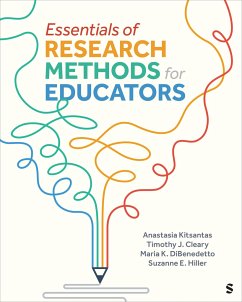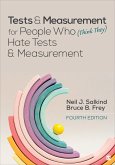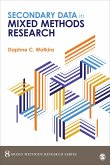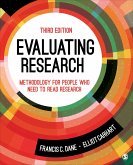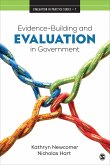Anastasia Kitsantas, Timothy Cleary, Maria K DiBenedetto
Essentials of Research Methods for Educators
Anastasia Kitsantas, Timothy Cleary, Maria K DiBenedetto
Essentials of Research Methods for Educators
- Broschiertes Buch
- Merkliste
- Auf die Merkliste
- Bewerten Bewerten
- Teilen
- Produkt teilen
- Produkterinnerung
- Produkterinnerung
Essentials of Research Methods for Educators provides future teachers, specialists, administrators and educational leaders with a textbook and a resource that goes beyond the classroom to use in your career. With a focus on the wide variety of data available to educators and the importance of data literacy for all those involved in education, this book presents research methods in a relatable educational context with a variety of concrete examples. The authors use their expertise in educational psychology to optimize learning. The structure of the book breaks down research into discrete steps…mehr
Andere Kunden interessierten sich auch für
![Tests & Measurement for People Who (Think They) Hate Tests & Measurement Tests & Measurement for People Who (Think They) Hate Tests & Measurement]() Neil J. SalkindTests & Measurement for People Who (Think They) Hate Tests & Measurement96,99 €
Neil J. SalkindTests & Measurement for People Who (Think They) Hate Tests & Measurement96,99 €![Secondary Data in Mixed Methods Research Secondary Data in Mixed Methods Research]() Daphne C. WatkinsSecondary Data in Mixed Methods Research50,99 €
Daphne C. WatkinsSecondary Data in Mixed Methods Research50,99 €![Introduction to Intersectional Qualitative Research Introduction to Intersectional Qualitative Research]() Jennifer EspositoIntroduction to Intersectional Qualitative Research70,99 €
Jennifer EspositoIntroduction to Intersectional Qualitative Research70,99 €![Qualitative Research Writing Qualitative Research Writing]() Michelle SalmonaQualitative Research Writing31,99 €
Michelle SalmonaQualitative Research Writing31,99 €![Evaluating Research Evaluating Research]() Francis C. DaneEvaluating Research71,99 €
Francis C. DaneEvaluating Research71,99 €![Evidence-Building and Evaluation in Government Evidence-Building and Evaluation in Government]() Kathryn NewcomerEvidence-Building and Evaluation in Government31,99 €
Kathryn NewcomerEvidence-Building and Evaluation in Government31,99 €![Research Design Research Design]() Julianne CheekResearch Design70,99 €
Julianne CheekResearch Design70,99 €-
-
-
Essentials of Research Methods for Educators provides future teachers, specialists, administrators and educational leaders with a textbook and a resource that goes beyond the classroom to use in your career. With a focus on the wide variety of data available to educators and the importance of data literacy for all those involved in education, this book presents research methods in a relatable educational context with a variety of concrete examples. The authors use their expertise in educational psychology to optimize learning. The structure of the book breaks down research into discrete steps with the "Let's See It," "Let's Do It," and "You Do It" steps for each chapter so students feel motivated to complete their research projects. By covering qualitative, quantitative, and mixed methods research, with additional chapters on action research and program evaluation, students get a complete picture of the current research methods landscape. This highly scaffolded book supports future educational leaders in incorporating research and methods into their work and life.
Produktdetails
- Produktdetails
- Verlag: SAGE Publications, Inc / Sage Publications
- Seitenzahl: 760
- Erscheinungstermin: 22. Januar 2024
- Englisch
- Abmessung: 203mm x 258mm x 44mm
- Gewicht: 2288g
- ISBN-13: 9781071830697
- ISBN-10: 1071830694
- Artikelnr.: 68580682
- Herstellerkennzeichnung
- Libri GmbH
- Europaallee 1
- 36244 Bad Hersfeld
- gpsr@libri.de
- Verlag: SAGE Publications, Inc / Sage Publications
- Seitenzahl: 760
- Erscheinungstermin: 22. Januar 2024
- Englisch
- Abmessung: 203mm x 258mm x 44mm
- Gewicht: 2288g
- ISBN-13: 9781071830697
- ISBN-10: 1071830694
- Artikelnr.: 68580682
- Herstellerkennzeichnung
- Libri GmbH
- Europaallee 1
- 36244 Bad Hersfeld
- gpsr@libri.de
Anastasia Kitsantas, PhD, is Professor of Educational Psychology and Director of the Office of Doctoral Studies in the College of Education and Human Development at George Mason University (GMU). She has also served as Director of the Educational Psychology, Research Methods, and Education Policy Division and as Academic Program Coordinator of the Educational Psychology Program. She received her PhD in Educational Psychology with a specialization in Development, Learning, and Instruction from the Graduate School and University Center of the City University of New York. She has previously served on the faculties at James Madison University in the School of Psychology and at Florida State University in the Department of Educational Research. Prior to working in higher education, she taught in K-12 settings. Dr. Kitsantas' research interests focus on the development of self-regulated learning (SRL) and student motivation across diverse areas of functioning, including academic learning, athletics, and health. She has also studied the role of learning technologies in supporting student SRL. She finds joy in mentoring students to conduct research in these areas and has chaired more than 30 doctoral dissertations. She is the editor, coauthor, or author of three books and over 150 journal articles, book chapters, refereed proceedings, and reports, many of which are directed toward the training of self-regulation. Her publications have appeared in diverse outlets across many fields, such as educational psychology, teacher education, learning technologies, health psychology, and sport psychology. Her research output has been widely cited by others, with more than 19,000 Google Scholar citations. In fact, she has been recognized as ranking in the top 2% of scientists worldwide based on research conducted from Stanford University that covered ~7 million scientists in 22 major fields (Jeroen, Boyack, & Ioannidis, 2020). She has also presented over 200 papers or invited addresses at local, national, and international conferences. She has received funding support for her scholarship by various agencies. Currently, she is the Principal Investigator (PI) and a Co-PI on two projects funded by the Department of Education and the National Science Foundation, respectively. Both projects focus on the development of self-regulatory skills among school-aged students in literacy and STEM areas in preparation for postsecondary learning, the workplace, and lifelong learning. Dr. Kitsantas was awarded the Outstanding Dissertation Award by Division 15 of the American Psychological Association (APA) in 1997 and had been honored to receive the 2019 Barry J. Zimmerman Award for Outstanding Contributions to the fields of studying and self-regulated learning research by the Studying and Self-Regulated Learning (SSRL) Special Interest Group (SIG) of the American Educational Research Association (AERA). She is a Fellow of the American Psychological Association's: Division 15, Educational Psychology. She has excelled at teaching in a variety of course modalities and was awarded a George Mason University Teaching Excellence Award, which is an institutional recognition for outstanding teaching and acknowledgment of the significant work that faculty members devote to teaching, advising, mentoring, and curriculum development. She is the former Editor-in-Chief of The Journal of Experimental Education and has served on the editorial boards of a number of xxviii Essentials of Research Methods for Educators professional journals, including Contemporary Educational Psychology, Educational Technology, Research and Development, Metacognition and Learning, The Journal of Experimental Education, and many others. Dr. Kitsantas has been extensively involved in the profession and has held numerous leadership positions in professional organizations. She served as a Member at Large of the Executive Board of Division 15 of APA in 2011 and most recently served as the Chair of the Fellows Committee and the Webinar Committee. She has also been involved in the SSRLSIG of AERA as the SIG Chair, Program Chair, and Chair of the Barry J. Zimmerman Award Committee. She has been a panel reviewer for the Institute of Education Sciences, the National Science Foundation, and other funding agencies. She has developed partnerships with GMU and other universities abroad, taught abroad, and as an advocate for study abroad programs, continues to seed fruitful international collaborations.
Chapter 1: Introduction to Research
The Importance of Educational Research
Research as a Scientific Method
Basic Research Versus Applied Research
Ways in Which Educators Can Become Reflective Educator-Researchers
Key Logistical Factors and Diversity, Equity, and Inclusion Considerations in Conducting Research
Ethical Considerations
A Look Ahead: Organization of This Book
Chapter 2: Reviewing the Literature
Critical Issues in the Workplace
The Purpose of a Literature Review
Conduct a Literature Review
Synthesize Research
Formulate Research Problems or Questions
Ethical Considerations
American Psychological Association Style
Chapter 3: Research Design: The What, When, and How of Research
Introduction to Research Methodology and Design
Comparison of Quantitative and Qualitative Methodologies
Diversity of Research Designs Across Methodologies
Making Decisions About Research Methodology and Design
Cross-Cutting Themes for Research Methodology and Design
Ethical Considerations
American Psychological Association Style
Chapter 4: Non-Experimental Research Designs
Using Non-experimental Designs
Descriptive Designs
Correlational Designs
Comparative Designs
Ethical Considerations
American Psychological Association Style
Chapter 5: Experimental Research Designs
Deepening Knowledge About Threats to Internal Validity
Internal Validity Within Experimental Designs
Pre-Experimental Designs
True Experimental Designs
Quasi-Experimental Designs
Single-Participant Designs
Ethical Considerations
American Psychological Association Style
Chapter 6: Qualitative Research Designs
What Is Qualitative Research?
The Dynamic Nature of Qualitative Research
Types, Purposes, and Features of Qualitative Research Designs
The Qualitative Research Process
Ethical Considerations
American Psychological Association Style
Chapter 7: Mixed Methods Research Designs
Mixed Methods Research
Commonly Used Mixed Methods Research Designs
Development of a Mixed Methods Design Study
Making Sense of the Findings From Mixed Methods Research
Ethical Considerations
American Psychological Association Style
Chapter 8: Action Research for Educators
What Is Action Research?
Action Research and Other Research Methods
Rationale for Conducting Action Research for Work-Related Problems
Practical and Participatory Action Research
The Cycle of Action Research
Ethical Considerations
American Psychological Association Style
Chapter 9: Program Evaluation
Characteristics of Program Evaluation
Research Studies and Program Evaluations
Elements of Program Theory and Logic Models
Types and Purposes of Program Evaluations
Engaging in a Program Evaluation
Ethical Considerations
American Psychological Association Style
Chapter 10: Sampling and Measurement Learning Objectives
Sampling-Related Terminology
Probability and Non-probability Sampling Techniques
Sampling Across Quantitative, Qualitative, Mixed Methods, and Action Research
Measurement and Measurement Error in Research
Levels of Measurement
Types of Validity in Measurement
Types of Reliability in Measurement
Chapter 11: Data Collection
Intersection of Data Collection Instruments and Sources
Quantitative Data Collection Instruments Used in Educational Settings
Qualitative Data Collection Instruments Used in Educational Settings
Selecting Data Collection Instruments
Chapter 12: Descriptive Statistics
Key Components and Nature of Datasets
Purpose and Importance of Descriptive Statistics
Examining Distribution of Scores for a Variable
Central Tendency: Identifying the Most Typical or Representative Score of a Distribution
Measures of Variability Among Scores in a Distribution
Metrics to Capture the Relative Standing of Individuals From a Larger Group
Examining the Correlation Among Variables in a Dataset
Chapter 13: Inferential Statistics
The Purpose of Inferential Statistics
Measures of Variability
Probability and Statistical Significance
Hypothesis Testing and Statistical Significance
Various Inferential Tests
Chapter 14: Qualitative Analysis
The Researcher as the Instrument in Qualitative Research
Strategies for Developing Codes in Qualitative Data
Strategies for Building Themes in Qualitative Data
Comparison of Data Analysis Principles Across Research Design
Chapter 15: Communicating Research
The Importance of Communicating Research
Approaches to Written and Oral Communication of Research
Key Considerations When Communicating Research
The Role of Self-Regulated Learning in the Communication of Research
Chapter 16: Using Research to Guide Practice
Connecting Research With Practice
Evaluating the Quality of Research
Uses of Research for Teachers
Uses of Research for Administrators
Uses of Research for the Community and Policymakers
Using Research to Impact Higher Education Programs and Professional and Personal Growth
Applying Research Findings to Practice Using the Cycle of Self-Regulated Learning
The Importance of Educational Research
Research as a Scientific Method
Basic Research Versus Applied Research
Ways in Which Educators Can Become Reflective Educator-Researchers
Key Logistical Factors and Diversity, Equity, and Inclusion Considerations in Conducting Research
Ethical Considerations
A Look Ahead: Organization of This Book
Chapter 2: Reviewing the Literature
Critical Issues in the Workplace
The Purpose of a Literature Review
Conduct a Literature Review
Synthesize Research
Formulate Research Problems or Questions
Ethical Considerations
American Psychological Association Style
Chapter 3: Research Design: The What, When, and How of Research
Introduction to Research Methodology and Design
Comparison of Quantitative and Qualitative Methodologies
Diversity of Research Designs Across Methodologies
Making Decisions About Research Methodology and Design
Cross-Cutting Themes for Research Methodology and Design
Ethical Considerations
American Psychological Association Style
Chapter 4: Non-Experimental Research Designs
Using Non-experimental Designs
Descriptive Designs
Correlational Designs
Comparative Designs
Ethical Considerations
American Psychological Association Style
Chapter 5: Experimental Research Designs
Deepening Knowledge About Threats to Internal Validity
Internal Validity Within Experimental Designs
Pre-Experimental Designs
True Experimental Designs
Quasi-Experimental Designs
Single-Participant Designs
Ethical Considerations
American Psychological Association Style
Chapter 6: Qualitative Research Designs
What Is Qualitative Research?
The Dynamic Nature of Qualitative Research
Types, Purposes, and Features of Qualitative Research Designs
The Qualitative Research Process
Ethical Considerations
American Psychological Association Style
Chapter 7: Mixed Methods Research Designs
Mixed Methods Research
Commonly Used Mixed Methods Research Designs
Development of a Mixed Methods Design Study
Making Sense of the Findings From Mixed Methods Research
Ethical Considerations
American Psychological Association Style
Chapter 8: Action Research for Educators
What Is Action Research?
Action Research and Other Research Methods
Rationale for Conducting Action Research for Work-Related Problems
Practical and Participatory Action Research
The Cycle of Action Research
Ethical Considerations
American Psychological Association Style
Chapter 9: Program Evaluation
Characteristics of Program Evaluation
Research Studies and Program Evaluations
Elements of Program Theory and Logic Models
Types and Purposes of Program Evaluations
Engaging in a Program Evaluation
Ethical Considerations
American Psychological Association Style
Chapter 10: Sampling and Measurement Learning Objectives
Sampling-Related Terminology
Probability and Non-probability Sampling Techniques
Sampling Across Quantitative, Qualitative, Mixed Methods, and Action Research
Measurement and Measurement Error in Research
Levels of Measurement
Types of Validity in Measurement
Types of Reliability in Measurement
Chapter 11: Data Collection
Intersection of Data Collection Instruments and Sources
Quantitative Data Collection Instruments Used in Educational Settings
Qualitative Data Collection Instruments Used in Educational Settings
Selecting Data Collection Instruments
Chapter 12: Descriptive Statistics
Key Components and Nature of Datasets
Purpose and Importance of Descriptive Statistics
Examining Distribution of Scores for a Variable
Central Tendency: Identifying the Most Typical or Representative Score of a Distribution
Measures of Variability Among Scores in a Distribution
Metrics to Capture the Relative Standing of Individuals From a Larger Group
Examining the Correlation Among Variables in a Dataset
Chapter 13: Inferential Statistics
The Purpose of Inferential Statistics
Measures of Variability
Probability and Statistical Significance
Hypothesis Testing and Statistical Significance
Various Inferential Tests
Chapter 14: Qualitative Analysis
The Researcher as the Instrument in Qualitative Research
Strategies for Developing Codes in Qualitative Data
Strategies for Building Themes in Qualitative Data
Comparison of Data Analysis Principles Across Research Design
Chapter 15: Communicating Research
The Importance of Communicating Research
Approaches to Written and Oral Communication of Research
Key Considerations When Communicating Research
The Role of Self-Regulated Learning in the Communication of Research
Chapter 16: Using Research to Guide Practice
Connecting Research With Practice
Evaluating the Quality of Research
Uses of Research for Teachers
Uses of Research for Administrators
Uses of Research for the Community and Policymakers
Using Research to Impact Higher Education Programs and Professional and Personal Growth
Applying Research Findings to Practice Using the Cycle of Self-Regulated Learning
Chapter 1: Introduction to Research
The Importance of Educational Research
Research as a Scientific Method
Basic Research Versus Applied Research
Ways in Which Educators Can Become Reflective Educator-Researchers
Key Logistical Factors and Diversity, Equity, and Inclusion Considerations in Conducting Research
Ethical Considerations
A Look Ahead: Organization of This Book
Chapter 2: Reviewing the Literature
Critical Issues in the Workplace
The Purpose of a Literature Review
Conduct a Literature Review
Synthesize Research
Formulate Research Problems or Questions
Ethical Considerations
American Psychological Association Style
Chapter 3: Research Design: The What, When, and How of Research
Introduction to Research Methodology and Design
Comparison of Quantitative and Qualitative Methodologies
Diversity of Research Designs Across Methodologies
Making Decisions About Research Methodology and Design
Cross-Cutting Themes for Research Methodology and Design
Ethical Considerations
American Psychological Association Style
Chapter 4: Non-Experimental Research Designs
Using Non-experimental Designs
Descriptive Designs
Correlational Designs
Comparative Designs
Ethical Considerations
American Psychological Association Style
Chapter 5: Experimental Research Designs
Deepening Knowledge About Threats to Internal Validity
Internal Validity Within Experimental Designs
Pre-Experimental Designs
True Experimental Designs
Quasi-Experimental Designs
Single-Participant Designs
Ethical Considerations
American Psychological Association Style
Chapter 6: Qualitative Research Designs
What Is Qualitative Research?
The Dynamic Nature of Qualitative Research
Types, Purposes, and Features of Qualitative Research Designs
The Qualitative Research Process
Ethical Considerations
American Psychological Association Style
Chapter 7: Mixed Methods Research Designs
Mixed Methods Research
Commonly Used Mixed Methods Research Designs
Development of a Mixed Methods Design Study
Making Sense of the Findings From Mixed Methods Research
Ethical Considerations
American Psychological Association Style
Chapter 8: Action Research for Educators
What Is Action Research?
Action Research and Other Research Methods
Rationale for Conducting Action Research for Work-Related Problems
Practical and Participatory Action Research
The Cycle of Action Research
Ethical Considerations
American Psychological Association Style
Chapter 9: Program Evaluation
Characteristics of Program Evaluation
Research Studies and Program Evaluations
Elements of Program Theory and Logic Models
Types and Purposes of Program Evaluations
Engaging in a Program Evaluation
Ethical Considerations
American Psychological Association Style
Chapter 10: Sampling and Measurement Learning Objectives
Sampling-Related Terminology
Probability and Non-probability Sampling Techniques
Sampling Across Quantitative, Qualitative, Mixed Methods, and Action Research
Measurement and Measurement Error in Research
Levels of Measurement
Types of Validity in Measurement
Types of Reliability in Measurement
Chapter 11: Data Collection
Intersection of Data Collection Instruments and Sources
Quantitative Data Collection Instruments Used in Educational Settings
Qualitative Data Collection Instruments Used in Educational Settings
Selecting Data Collection Instruments
Chapter 12: Descriptive Statistics
Key Components and Nature of Datasets
Purpose and Importance of Descriptive Statistics
Examining Distribution of Scores for a Variable
Central Tendency: Identifying the Most Typical or Representative Score of a Distribution
Measures of Variability Among Scores in a Distribution
Metrics to Capture the Relative Standing of Individuals From a Larger Group
Examining the Correlation Among Variables in a Dataset
Chapter 13: Inferential Statistics
The Purpose of Inferential Statistics
Measures of Variability
Probability and Statistical Significance
Hypothesis Testing and Statistical Significance
Various Inferential Tests
Chapter 14: Qualitative Analysis
The Researcher as the Instrument in Qualitative Research
Strategies for Developing Codes in Qualitative Data
Strategies for Building Themes in Qualitative Data
Comparison of Data Analysis Principles Across Research Design
Chapter 15: Communicating Research
The Importance of Communicating Research
Approaches to Written and Oral Communication of Research
Key Considerations When Communicating Research
The Role of Self-Regulated Learning in the Communication of Research
Chapter 16: Using Research to Guide Practice
Connecting Research With Practice
Evaluating the Quality of Research
Uses of Research for Teachers
Uses of Research for Administrators
Uses of Research for the Community and Policymakers
Using Research to Impact Higher Education Programs and Professional and Personal Growth
Applying Research Findings to Practice Using the Cycle of Self-Regulated Learning
The Importance of Educational Research
Research as a Scientific Method
Basic Research Versus Applied Research
Ways in Which Educators Can Become Reflective Educator-Researchers
Key Logistical Factors and Diversity, Equity, and Inclusion Considerations in Conducting Research
Ethical Considerations
A Look Ahead: Organization of This Book
Chapter 2: Reviewing the Literature
Critical Issues in the Workplace
The Purpose of a Literature Review
Conduct a Literature Review
Synthesize Research
Formulate Research Problems or Questions
Ethical Considerations
American Psychological Association Style
Chapter 3: Research Design: The What, When, and How of Research
Introduction to Research Methodology and Design
Comparison of Quantitative and Qualitative Methodologies
Diversity of Research Designs Across Methodologies
Making Decisions About Research Methodology and Design
Cross-Cutting Themes for Research Methodology and Design
Ethical Considerations
American Psychological Association Style
Chapter 4: Non-Experimental Research Designs
Using Non-experimental Designs
Descriptive Designs
Correlational Designs
Comparative Designs
Ethical Considerations
American Psychological Association Style
Chapter 5: Experimental Research Designs
Deepening Knowledge About Threats to Internal Validity
Internal Validity Within Experimental Designs
Pre-Experimental Designs
True Experimental Designs
Quasi-Experimental Designs
Single-Participant Designs
Ethical Considerations
American Psychological Association Style
Chapter 6: Qualitative Research Designs
What Is Qualitative Research?
The Dynamic Nature of Qualitative Research
Types, Purposes, and Features of Qualitative Research Designs
The Qualitative Research Process
Ethical Considerations
American Psychological Association Style
Chapter 7: Mixed Methods Research Designs
Mixed Methods Research
Commonly Used Mixed Methods Research Designs
Development of a Mixed Methods Design Study
Making Sense of the Findings From Mixed Methods Research
Ethical Considerations
American Psychological Association Style
Chapter 8: Action Research for Educators
What Is Action Research?
Action Research and Other Research Methods
Rationale for Conducting Action Research for Work-Related Problems
Practical and Participatory Action Research
The Cycle of Action Research
Ethical Considerations
American Psychological Association Style
Chapter 9: Program Evaluation
Characteristics of Program Evaluation
Research Studies and Program Evaluations
Elements of Program Theory and Logic Models
Types and Purposes of Program Evaluations
Engaging in a Program Evaluation
Ethical Considerations
American Psychological Association Style
Chapter 10: Sampling and Measurement Learning Objectives
Sampling-Related Terminology
Probability and Non-probability Sampling Techniques
Sampling Across Quantitative, Qualitative, Mixed Methods, and Action Research
Measurement and Measurement Error in Research
Levels of Measurement
Types of Validity in Measurement
Types of Reliability in Measurement
Chapter 11: Data Collection
Intersection of Data Collection Instruments and Sources
Quantitative Data Collection Instruments Used in Educational Settings
Qualitative Data Collection Instruments Used in Educational Settings
Selecting Data Collection Instruments
Chapter 12: Descriptive Statistics
Key Components and Nature of Datasets
Purpose and Importance of Descriptive Statistics
Examining Distribution of Scores for a Variable
Central Tendency: Identifying the Most Typical or Representative Score of a Distribution
Measures of Variability Among Scores in a Distribution
Metrics to Capture the Relative Standing of Individuals From a Larger Group
Examining the Correlation Among Variables in a Dataset
Chapter 13: Inferential Statistics
The Purpose of Inferential Statistics
Measures of Variability
Probability and Statistical Significance
Hypothesis Testing and Statistical Significance
Various Inferential Tests
Chapter 14: Qualitative Analysis
The Researcher as the Instrument in Qualitative Research
Strategies for Developing Codes in Qualitative Data
Strategies for Building Themes in Qualitative Data
Comparison of Data Analysis Principles Across Research Design
Chapter 15: Communicating Research
The Importance of Communicating Research
Approaches to Written and Oral Communication of Research
Key Considerations When Communicating Research
The Role of Self-Regulated Learning in the Communication of Research
Chapter 16: Using Research to Guide Practice
Connecting Research With Practice
Evaluating the Quality of Research
Uses of Research for Teachers
Uses of Research for Administrators
Uses of Research for the Community and Policymakers
Using Research to Impact Higher Education Programs and Professional and Personal Growth
Applying Research Findings to Practice Using the Cycle of Self-Regulated Learning

